snow chains MITSUBISHI SHOGUN 2003 Owner's Manual (in English)
[x] Cancel search | Manufacturer: MITSUBISHI, Model Year: 2003, Model line: SHOGUN, Model: MITSUBISHI SHOGUN 2003Pages: 392, PDF Size: 14.34 MB
Page 196 of 392
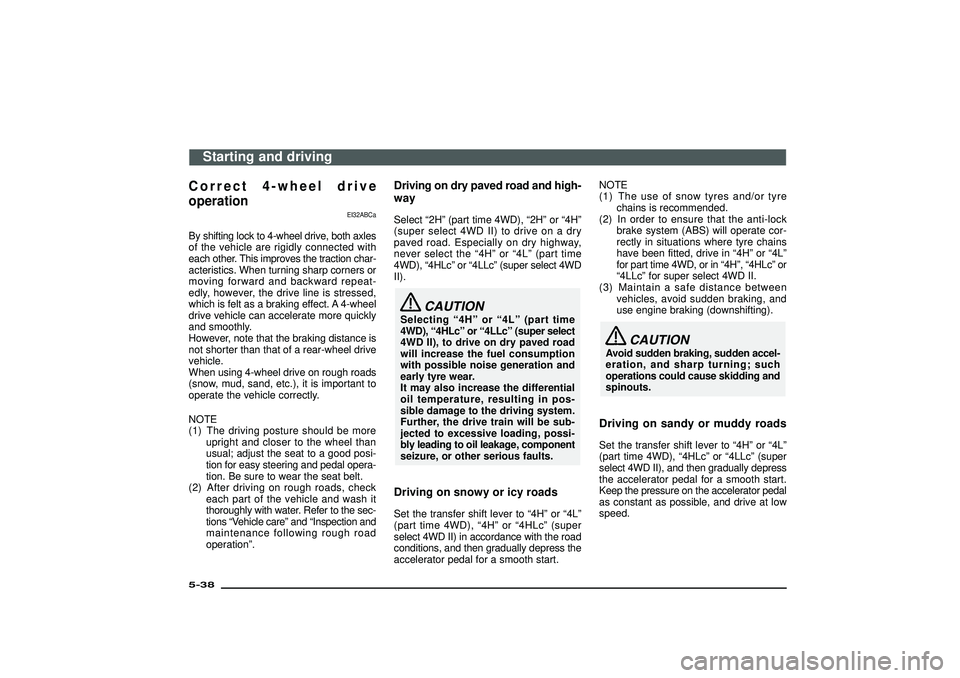
Correct 4-wheel drive
operation
EI32ABCa
By shifting lock to 4-wheel drive, both axles
of the vehicle are rigidly connected with
each other. This improves the traction char-
acteristics. When turning sharp corners or
moving forward and backward repeat-
edly, however, the drive line is stressed,
which is felt as a braking effect. A 4-wheel
drive vehicle can accelerate more quickly
and smoothly.
However, note that the braking distance is
not shorter than that of a rear-wheel drive
vehicle.
When using 4-wheel drive on rough roads
(snow, mud, sand, etc.), it is important to
operate the vehicle correctly.
NOTE
(1) The driving posture should be more
upright and closer to the wheel than
usual; adjust the seat to a good posi-
tion for easy steering and pedal opera-
tion. Be sure to wear the seat belt.
(2) After driving on rough roads, check
each part of the vehicle and wash it
thoroughly with water. Refer to the sec-
tions“Vehicle care”and“Inspection and
maintenance following rough road
operation”.
Driving on dry paved road and high-
waySelect“2H”(part time 4WD),“2H”or“4H”
(super select 4WD II) to drive on a dry
paved road. Especially on dry highway,
never select the“4H”or“4L”(part time
4WD),“4HLc”or“4LLc”(super select 4WD
II).
CAUTION
Selecting“4H”or“4L”(part time
4WD),“4HLc”or“4LLc”(super select
4WD II), to drive on dry paved road
will increase the fuel consumption
with possible noise generation and
early tyre wear.
It may also increase the differential
oil temperature, resulting in pos-
sible damage to the driving system.
Further, the drive train will be sub-
jected to excessive loading, possi-
bly leading to oil leakage, component
seizure, or other serious faults.Driving on snowy or icy roadsSet the transfer shift lever to“4H”or“4L”
(part time 4WD),“4H”or“4HLc”(super
select 4WD II) in accordance with the road
conditions, and then gradually depress the
accelerator pedal for a smooth start.NOTE
(1) The use of snow tyres and/or tyre
chains is recommended.
(2) In order to ensure that the anti-lock
brake system (ABS) will operate cor-
rectly in situations where tyre chains
have been fitted, drive in“4H”or“4L”
for part time 4WD, or in“4H”,“4HLc”or
“4LLc”for super select 4WD II.
(3) Maintain a safe distance between
vehicles, avoid sudden braking, and
use engine braking (downshifting).
CAUTION
Avoid sudden braking, sudden accel-
eration, and sharp turning; such
operations could cause skidding and
spinouts.Driving on sandy or muddy roadsSet the transfer shift lever to“4H”or“4L”
(part time 4WD),“4HLc”or“4LLc”(super
select 4WD II), and then gradually depress
the accelerator pedal for a smooth start.
Keep the pressure on the accelerator pedal
as constant as possible, and drive at low
speed.
Starting and driving
5-38Div:
Out put date:
Page 203 of 392
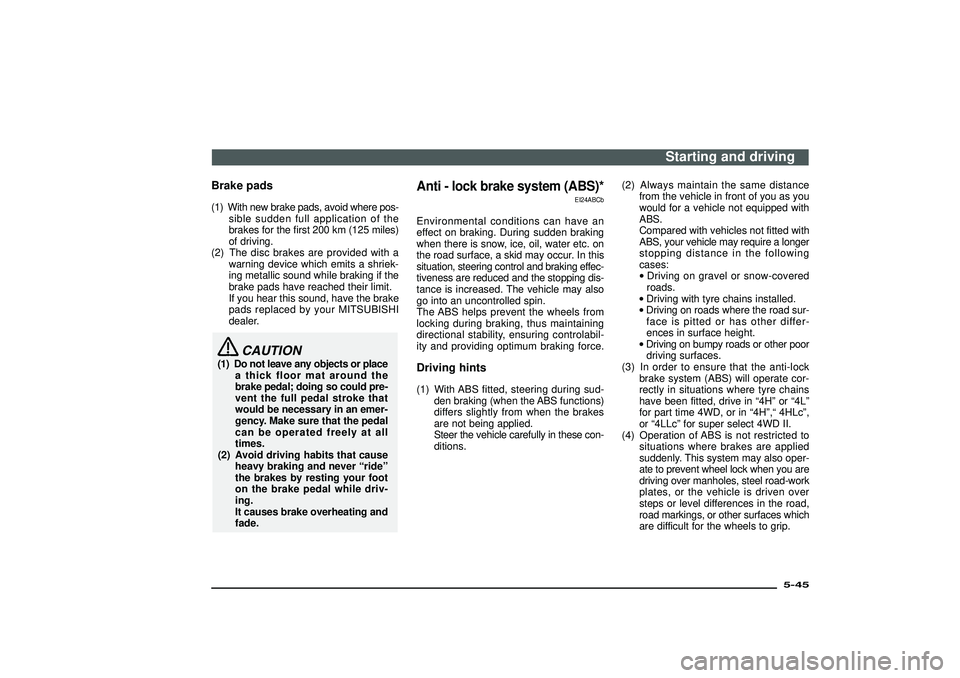
Brake pads(1) With new brake pads, avoid where pos-
sible sudden full application of the
brakes for the first 200 km (125 miles)
of driving.
(2) The disc brakes are provided with a
warning device which emits a shriek-
ing metallic sound while braking if the
brake pads have reached their limit.
If you hear this sound, have the brake
pads replaced by your MITSUBISHI
dealer.
CAUTION
(1) Do not leave any objects or place
a thick floor mat around the
brake pedal; doing so could pre-
vent the full pedal stroke that
would be necessary in an emer-
gency. Make sure that the pedal
can be operated freely at all
times.
(2) Avoid driving habits that cause
heavy braking and never“ride”
the brakes by resting your foot
on the brake pedal while driv-
ing.
It causes brake overheating and
fade.
Anti - lock brake system (ABS)*
EI24ABCb
Environmental conditions can have an
effect on braking. During sudden braking
when there is snow, ice, oil, water etc. on
the road surface, a skid may occur. In this
situation, steering control and braking effec-
tiveness are reduced and the stopping dis-
tance is increased. The vehicle may also
go into an uncontrolled spin.
The ABS helps prevent the wheels from
locking during braking, thus maintaining
directional stability, ensuring controlabil-
ity and providing optimum braking force.Driving hints(1) With ABS fitted, steering during sud-
den braking (when the ABS functions)
differs slightly from when the brakes
are not being applied.
Steer the vehicle carefully in these con-
ditions.(2) Always maintain the same distance
from the vehicle in front of you as you
would for a vehicle not equipped with
ABS.
Compared with vehicles not fitted with
ABS, your vehicle may require a longer
stopping distance in the following
cases:
•Driving on gravel or snow-covered
roads.
•Driving with tyre chains installed.
•Driving on roads where the road sur-
face is pitted or has other differ-
ences in surface height.
•Driving on bumpy roads or other poor
driving surfaces.
(3) In order to ensure that the anti-lock
brake system (ABS) will operate cor-
rectly in situations where tyre chains
have been fitted, drive in“4H”or“4L”
for part time 4WD, or in“4H”,“4HLc”,
or“4LLc”for super select 4WD II.
(4) Operation of ABS is not restricted to
situations where brakes are applied
suddenly. This system may also oper-
ate to prevent wheel lock when you are
driving over manholes, steel road-work
plates, or the vehicle is driven over
steps or level differences in the road,
road markings, or other surfaces which
are difficult for the wheels to grip.
Starting and driving
5-45
Div:
Out put date:
Page 301 of 392
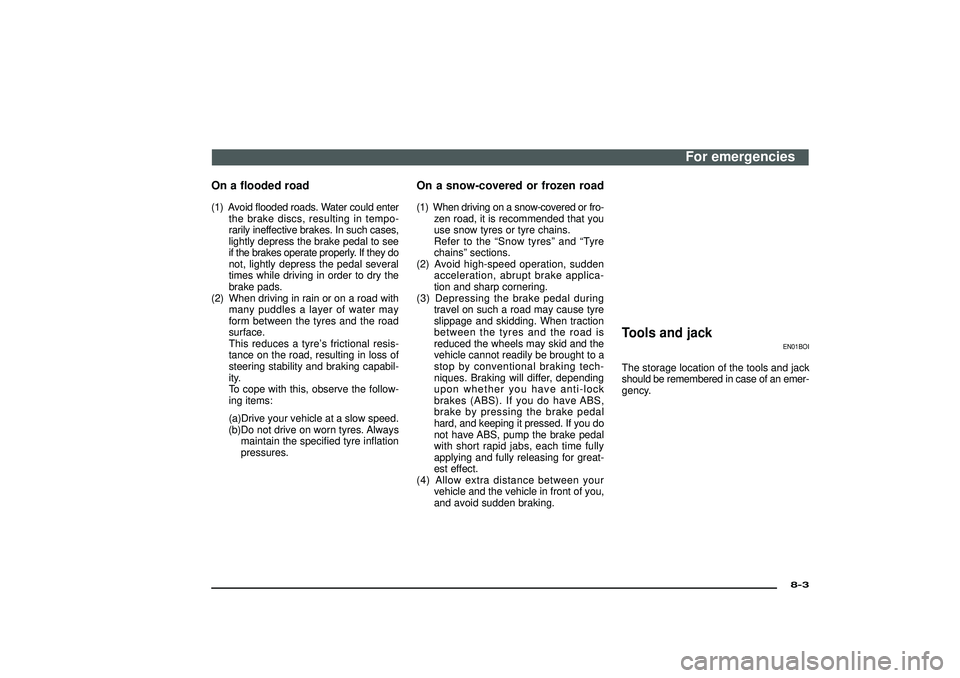
On a flooded road(1) Avoid flooded roads. Water could enter
the brake discs, resulting in tempo-
rarily ineffective brakes. In such cases,
lightly depress the brake pedal to see
if the brakes operate properly. If they do
not, lightly depress the pedal several
times while driving in order to dry the
brake pads.
(2) When driving in rain or on a road with
many puddles a layer of water may
form between the tyres and the road
surface.
This reduces a tyre’s frictional resis-
tance on the road, resulting in loss of
steering stability and braking capabil-
ity.
To cope with this, observe the follow-
ing items:
(a)Drive your vehicle at a slow speed.
(b)Do not drive on worn tyres. Always
maintain the specified tyre inflation
pressures.
On a snow-covered or frozen road(1) When driving on a snow-covered or fro-
zen road, it is recommended that you
use snow tyres or tyre chains.
Refer to the“Snow tyres”and“Tyre
chains”sections.
(2) Avoid high-speed operation, sudden
acceleration, abrupt brake applica-
tion and sharp cornering.
(3) Depressing the brake pedal during
travel on such a road may cause tyre
slippage and skidding. When traction
between the tyres and the road is
reduced the wheels may skid and the
vehicle cannot readily be brought to a
stop by conventional braking tech-
niques. Braking will differ, depending
upon whether you have anti-lock
brakes (ABS). If you do have ABS,
brake by pressing the brake pedal
hard, and keeping it pressed. If you do
not have ABS, pump the brake pedal
with short rapid jabs, each time fully
applying and fully releasing for great-
est effect.
(4) Allow extra distance between your
vehicle and the vehicle in front of you,
and avoid sudden braking.
Tools and jack
EN01BOI
The storage location of the tools and jack
should be remembered in case of an emer-
gency.
For emergencies
8-3
Div:
Out put date:
Page 343 of 392
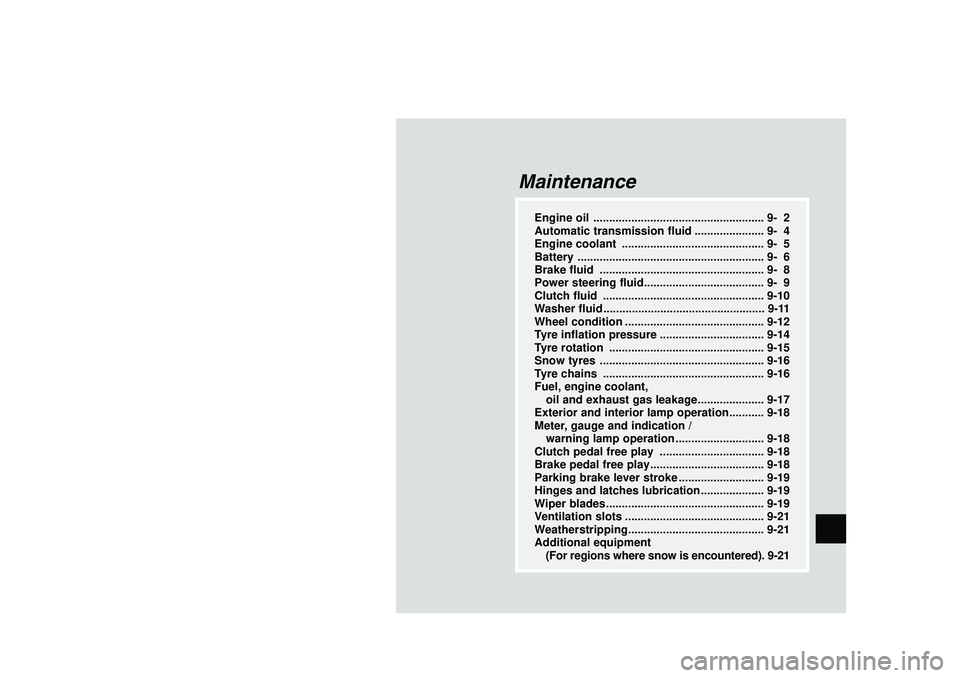
Maintenance
Engine oil ...................................................... 9- 2
Automatic transmission fluid ...................... 9- 4
Engine coolant ............................................. 9- 5
Battery ........................................................... 9- 6
Brake fluid .................................................... 9- 8
Power steering fluid...................................... 9- 9
Clutch fluid ................................................... 9-10
Washer fluid ................................................... 9-11
Wheel condition ............................................ 9-12
Tyre inflation pressure ................................. 9-14
Tyre rotation ................................................. 9-15
Snow tyres .................................................... 9-16
Tyre chains ................................................... 9-16
Fuel, engine coolant,
oil and exhaust gas leakage..................... 9-17
Exterior and interior lamp operation........... 9-18
Meter, gauge and indication /
warning lamp operation ............................ 9-18
Clutch pedal free play ................................. 9-18
Brake pedal free play.................................... 9-18
Parking brake lever stroke ........................... 9-19
Hinges and latches lubrication.................... 9-19
Wiper blades.................................................. 9-19
Ventilation slots ............................................ 9-21
Weatherstripping........................................... 9-21
Additional equipment
(For regions where snow is encountered). 9-21
Div:
Out put date:
Page 358 of 392
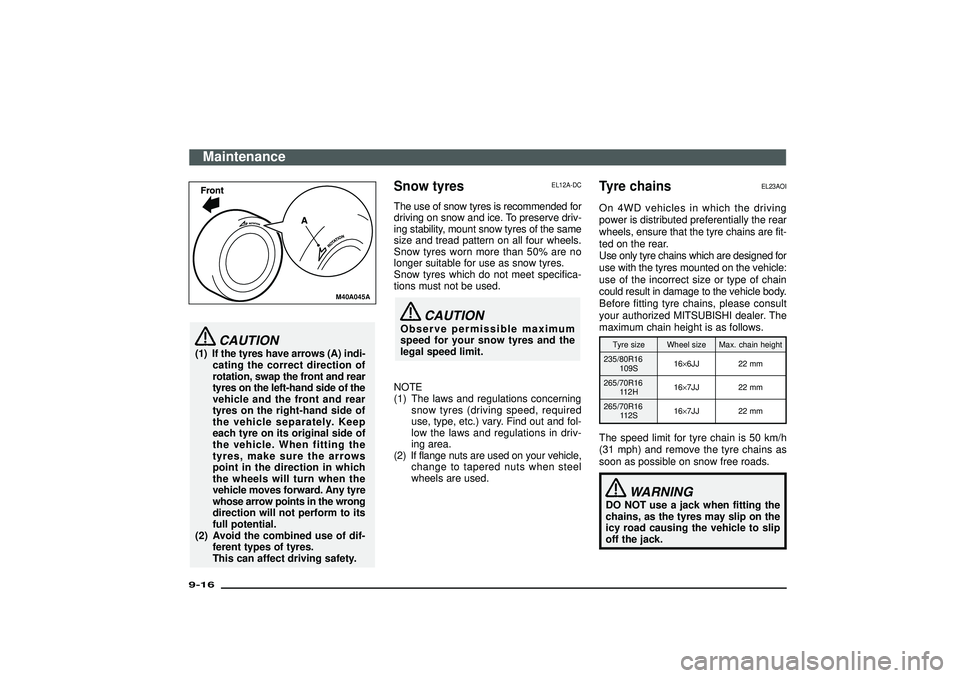
M40A045A
CAUTION
(1) If the tyres have arrows (A) indi-
cating the correct direction of
rotation, swap the front and rear
tyres on the left-hand side of the
vehicle and the front and rear
tyres on the right-hand side of
the vehicle separately. Keep
each tyre on its original side of
the vehicle. When fitting the
tyres, make sure the arrows
point in the direction in which
the wheels will turn when the
vehicle moves forward. Any tyre
whose arrow points in the wrong
direction will not perform to its
full potential.
(2) Avoid the combined use of dif-
ferent types of tyres.
This can affect driving safety.
Snow tyres
EL12A-DC
The use of snow tyres is recommended for
driving on snow and ice. To preserve driv-
ing stability, mount snow tyres of the same
size and tread pattern on all four wheels.
Snow tyres worn more than 50% are no
longer suitable for use as snow tyres.
Snow tyres which do not meet specifica-
tions must not be used.
CAUTION
Observe permissible maximum
speed for your snow tyres and the
legal speed limit.
NOTE
(1) The laws and regulations concerning
snow tyres (driving speed, required
use, type, etc.) vary. Find out and fol-
low the laws and regulations in driv-
ing area.
(2) If flange nuts are used on your vehicle,
change to tapered nuts when steel
wheels are used.
Tyre chains
EL23AOI
On 4WD vehicles in which the driving
power is distributed preferentially the rear
wheels, ensure that the tyre chains are fit-
ted on the rear.
Use only tyre chains which are designed for
use with the tyres mounted on the vehicle:
use of the incorrect size or type of chain
could result in damage to the vehicle body.
Before fitting tyre chains, please consult
your authorized MITSUBISHI dealer. The
maximum chain height is as follows.
Tyre size Wheel size Max. chain height
235/80R16
109S16×6JJ 22 mm
265/70R16
112H16×7JJ 22 mm
265/70R16
112S16×7JJ 22 mm
The speed limit for tyre chain is 50 km/h
(31 mph) and remove the tyre chains as
soon as possible on snow free roads.
WARNING
DO NOT use a jack when fitting the
chains, as the tyres may slip on the
icy road causing the vehicle to slip
off the jack.
Maintenance
9-16Div:
Out put date:
Page 359 of 392
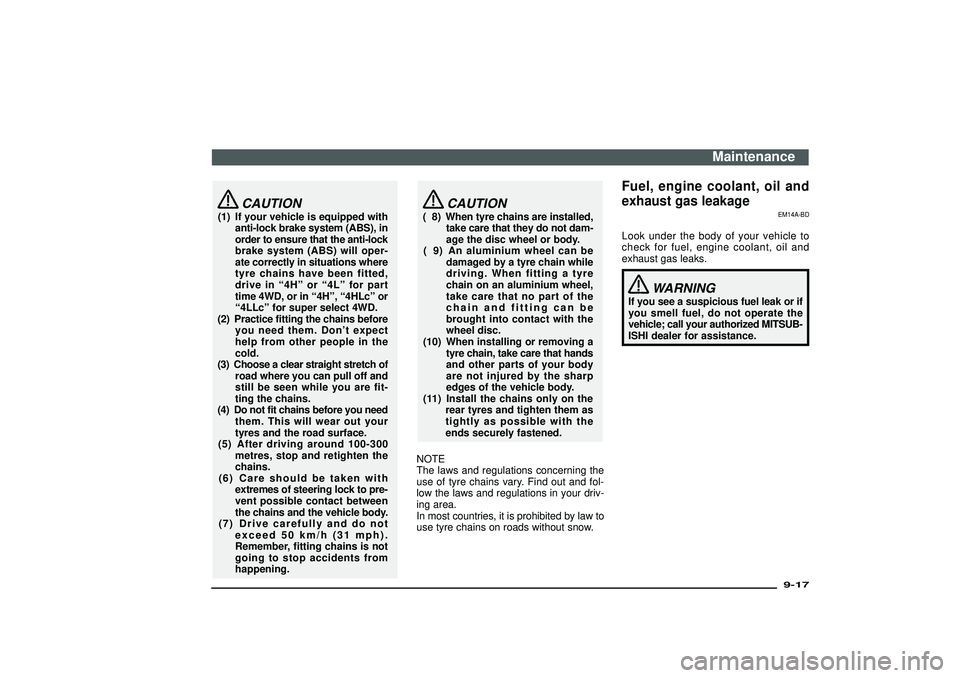
CAUTION
(1) If your vehicle is equipped with
anti-lock brake system (ABS), in
order to ensure that the anti-lock
brake system (ABS) will oper-
ate correctly in situations where
tyre chains have been fitted,
drive in“4H”or“4L”for part
time 4WD, or in“4H”,“4HLc”or
“4LLc”for super select 4WD.
(2) Practice fitting the chains before
you need them. Don’t expect
help from other people in the
cold.
(3) Choose a clear straight stretch of
road where you can pull off and
still be seen while you are fit-
ting the chains.
(4) Do not fit chains before you need
them. This will wear out your
tyres and the road surface.
(5) After driving around 100-300
metres, stop and retighten the
chains.
(6) Care should be taken with
extremes of steering lock to pre-
vent possible contact between
the chains and the vehicle body.
(7) Drive carefully and do not
exceed 50 km/h (31 mph).
Remember, fitting chains is not
going to stop accidents from
happening.
CAUTION
( 8) When tyre chains are installed,
take care that they do not dam-
age the disc wheel or body.
( 9) An aluminium wheel can be
damaged by a tyre chain while
driving. When fitting a tyre
chain on an aluminium wheel,
take care that no part of the
chain and fitting can be
brought into contact with the
wheel disc.
(10) When installing or removing a
tyre chain, take care that hands
and other parts of your body
are not injured by the sharp
edges of the vehicle body.
(11) Install the chains only on the
rear tyres and tighten them as
tightly as possible with the
ends securely fastened.
NOTE
The laws and regulations concerning the
use of tyre chains vary. Find out and fol-
low the laws and regulations in your driv-
ing area.
In most countries, it is prohibited by law to
use tyre chains on roads without snow.
Fuel, engine coolant, oil and
exhaust gas leakage
EM14A-BD
Look under the body of your vehicle to
check for fuel, engine coolant, oil and
exhaust gas leaks.
WARNING
If you see a suspicious fuel leak or if
you smell fuel, do not operate the
vehicle; call your authorized MITSUB-
ISHI dealer for assistance.
Maintenance
9-17
Div:
Out put date:
Page 383 of 392

Parking ............................................................... 5-43
Parking brake ..................................................... 5-42
Parking brake lever stroke ................................. 9-19
Part time 4WD ................................................... 5-24
Performance ...................................................... 10-7
Power steering fluid ............................................. 9-9
Power steering system ...................................... 5-49
Pregnant women restraint .................................. 3-41
Rear differential lock .......................................... 5-34
Rear fog lamp switch ......................................... 4-22
Rear heater/Rear air conditioning ...................... 6-52
Rear seat (3-door models)/Second seat (5-door models) ......................... 3-12
Rear shelf (3-door models) ................................ 6-69
Rear side/quarter window .................................. 2-15
Rear window demister switch ............................ 4-21
Rear window wiper and washer switch .............. 4-19
Removal of water from the fuel filter (diesel- powered vehicles only) ...................... 8-24
Replacement of lamp bulbs ............................... 8-34
Rheostat (meter illumination control) ................. 4-23
Roof carrier precaution ....................................... 1-11
Room lamps ....................................................... 4-24
Running-in recommendations .............................. 5-2
RV meter ............................................................ 4-40
Safe driving techniques ..................................... 1-13
Seat adjustment ................................................... 3-3
Seat arrangement ................................................ 3-3
Seat belt inspection ........................................... 3-41
Seat belts ........................................................... 3-30
Side box ............................................................. 6-67
Snow tyres ......................................................... 9-16
Spare wheel ....................................................... 8-11
Speedometer ....................................................... 4-2
Starting ............................................................... 5-12
Steering wheel height adjustment ...................... 5-49
Sun visors .......................................................... 6-56
Sunroof .............................................................. 2-15
Super select 4WD II (SS4 II) ............................. 5-28
Supplemental restraint system (SRS)-air bag ... 3-42 Tachometer .......................................................... 4-3
Third seat (5-door models) ................................ 3-14
Tools and jack ...................................................... 8-3
Towing ................................................................ 8-17
Trailer towing ....................................................... 5-8
Transmission ...................................................... 10-9
Tyre chains ......................................................... 9-16
Tyre inflation pressure ....................................... 9-14
Tyre rotation ....................................................... 9-15
Tyres and wheels ............................................. 10-10
UKW/MW/LW electronic tuning radio
with CD player ................................................ 6-17
UKW/MW/LW electronic tuning radio with tape player ................................................ 6-2
Used engine oils safety instructions .................. 1-13
Vanity mirror ....................................................... 6-58
Vehicle identification number plate (RHD vehicles only) ....................................... 10-3
Vehicle information code plate ........................... 10-3
Ventilation slots .................................................. 9-21
Ventilators .......................................................... 6-35
Washer fluid ....................................................... 9-11
Water temperature gauge .................................... 4-5
Weatherstripping ................................................ 9-21
Weight ................................................................ 10-7
Wheel condition ................................................. 9-12
Windscreen wiper and washer switch ................ 4-17
Wiper blades ............................................... 7-7, 9-19
Wiper deicer switch ........................................... 4-24
Alphabetical index
10 -19
Div:
Out put date: